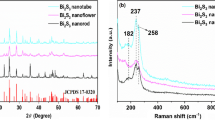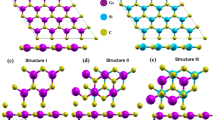Abstract
Fantastic two-dimensional (2-D) materials have been used in various fields, especially in green energy fields, because of their unique structures and accompanied physical properties. Here, we theoretically propose a novel 2-D materials family namely penta-B2X (X = S, Se, Te) that can perfectly meet the needs of photocatalytic water splitting. The penta-B2S, penta-B2Se and penta-B2Te all belong to semiconductors with indirect bandgaps of 1.889 eV, 1.998 eV and 1.928 eV, respectively. More importantly, we note that the penta-B2X (X = S, Se, Te) family has high (up to ~ 105 cm−1) and anisotropic light absorption coefficients in the visible-ultraviolet region, and their band edge positions are able to nicely satisfy the redox potentials at pH = 7 without external adjustment. Besides, they have high and anisotropic carrier mobility (up to ~ 103 cm2V−1 s−1) to ensure that the recombination of photogenerated carriers can be effectively reduced. Meanwhile, the penta-B2X (X = S, Se, Te) family possesses interesting in-plane negative Poisson's ratios (NPR) of − 0.141, − 0.117 and − 0.059, respectively. Thus, our results suggest that penta-B2X (X = S, Se, Te) can be used not only as promising water splitting photocatalysts with excellent performances but also for the design of funny nano electromechanical devices.







Similar content being viewed by others
References
Geim AK, Novoselov KS (2007) The rise of graphene. Nat Mater 6:183–191
Gupta A, Sakthivel T, Seal S (2015) Recent development in 2D materials beyond graphene. Prog Mater Sci 73:44–126
Yang FX, Cheng SS, Zhang XT, Ren XC, Li RJ, Dong HL, Hu WP (2018) 2D organic materials for optoelectronic applications. Adv Mater 30:1702415–1702441
Dunn B, Kamath H, Tarascon JM (2011) Electrical energy storage for the grid: a battery of choices. Science 334:928–935
Sun YQ, Wu Q, Shi GQ (2011) Graphene based new energy materials. Energy Environ Sci 4:1113–1132
Bak T, Nowotny J, Rekas M, Sorrell CC (2002) Photo-electrochemical hydrogen generation from water using solar energy. Materials-related aspects. Int. J. Hydrogen Energy 27:991–1022
Singh AK, Mathew K, Zhuang HL, Hennig RG (2015) Computational screening of 2D materials for photocatalysis. J Phys Chem Lett 6:1087–1098
Sun YF, Sun ZH, Gao S, Cheng H, Liu QH, Piao JY et al (2012) Fabrication of flexible and freestanding zinc chalcogenide single layers. Nat Commun 3:1–7
Sun YF, Cheng H, Gao S, Sun ZH, Li QH, Liu Q et al (2012) Freestanding tin disulfide single-layers realizing efficient visible-light water splitting. Angew Chem Int Ed Engl 51:8727–8731
Rahman MZ, Kwong CW, Davey K, Qiao SZ (2016) 2D phosphorene as a water splitting photocatalyst: fundamentals to applications. Energy Environ Sci 9:709–728
Zhang SL, Xie MQ, Li FY, Yan Z, Li YF, Kan EJ et al (2016) Semiconducting group 15 monolayers: a broad range of band gaps and high carrier mobilities. Angew Chem 128:1698–1701
Wang XC, Maeda K, Thomas A, Takanabe K, Xin G, Carlsson JM et al (2009) A metal-free polymeric photocatalyst for hydrogen production from water under visible light. Nat Mater 8:76–80
Luo Y, Ren K, Wang S, Chou JP, Yu J, Sun ZM et al (2019) First-principles study on transition-metal dichalcogenide/BSe van der Waals heterostructures: a promising water-splitting photocatalyst. J Phys Chem C 123:22742–22751
Ren K, Luo Y, Wang S, Chuo JP, Yu J, Tang WC et al (2019) A van der Waals heterostructure based on graphene-like gallium nitride and boron selenide: a high-efficiency photocatalyst for water splitting. ACS Omega 4:21689–21697
Lai K, Yan CL, Gao LQ, Zhang WB (2018) AI3 (A= As, Sb) single layers and their vdW heterostructure for photocatalysis and solar cell applications. J Phys Chem C 122:7656–7663
Lu BC, Zheng XY, Li ZS (2020) Two-dimensional lateral heterostructures of triphosphides: AlP3–GaP3 as a promising photocatalyst for water splitting. ACS Appl Mater Interfaces 12:53731–53738
Zhuang HL, Hennig RG (2013) Single-layer group-III monochalcogenide photocatalysts for water splitting. Chem Mater 25:3232–3238
Chen WZ, Huo XH, Shi XQ, Pan H (2018) Two-dimensional janus transition metal oxides and chalcogenides: multifunctional properties for photocatalysts, electronics, and energy conversion. ACS Appl Mater Interfaces 10:35289–35295
Zhang SH, Zhou J, Wang Q, Chen XS, Kawazoe Y, Jena P (2015) Penta-graphene: a new carbon allotrope. Proc Natl Acad USA 112:2372–2377
Xiao B, Li YC, Yu XF, Cheng JB (2016) Penta-graphene: a promising anode material as the Li/Na-ion battery with both extremely high theoretical capacity and fast charge/discharge rate. ACS Appl Mater Interfaces 8:35342–35352
Xu XF, Varshney V, Lee J, Zhang T, Wohlwend JL, Roy AK et al (2016) Hydrogenation of penta-graphene leads to unexpected large improvement in thermal conductivity. Nano Lett 16:3925–3935
Cheng MQ, Chen Q, Yang K, Huang WQ, Hu WY, Huang GF (2019) Penta-graphene as a potential gas sensor for NOx detection. Nanoscale Res Lett 14:1–8
Gao ZB, Wang JS (2020) Thermoelectric penta-silicene with a high room-temperature figure of merit. ACS Appl Mater Interfaces 12:14298–14307
Li FY, Tu KX, Zhang HJ, Chen ZF (2015) Flexible structural and electronic properties of A pentagonal B2C monolayer via external strain: a computational investigation. Phys Chem Chem Phys 17:24151–24156
Zhang T, Ma YD, Huang BB, Dai Y (2019) Two-dimensional penta-BN2 with high specific capacity for Li–ion batteries. ACS Appl Mater Interfaces 11:6104–6110
Li G, Yin SQ, Tan CY, Chen LJ, Yu MX, Li L et al (2021) Fast photothermoelectric response in CVD-grown PdSe2 photodetectors with in-plane anisotropy. Adv Funct Mater 31:2104787–2104793
Li PY, Zhang JT, Zhu C, Shen WF, Hu CG, Fu W et al (2021) Penta-PdPSe: a new 2D pentagonal material with highly in-plane optical, electronic, and optoelectronic anisotropy. Adv Mater 33:2102541–2102552
Kresse G, Furthmuller J (1996) Efficient Iterative schemes for ab initio total-energy calculations using a plane-wave basis set. Phys Rev B 54:11169
Perdew JP, Burke K, Ernzerhof M (1996) Generalized gradient approximation made simple. Phys Rev Lett 77:3865–3868
Gonze X, Lee CY (1997) Dynamical matrices, born effective charges, dielectric permittivity tensors, and interatomic force constants from density-functional perturbation theory. Phys Rev B Condens Matter Mater Phys 55:10355–10368
Cimas Á, Tielens F, Sulpizi M, Gaigeot MP, Costa D (2014) The amorphous silica–liquid water interface studied by ab initio molecular dynamics (AIMD): local organization in global disorder. J. Phys. Condens. Matter. 26:244106–244115
Deák P, Aradi B, Frauenheim T, Janzén E, Gali A (2010) Accurate defect levels obtained from the HSE06 range-separated hybrid functional. Phys. Rev. B 81:153203–153206
Andrew RC, Mapasha RE, Ukpong AM, Chetty N (2012) Mechanical properties of graphene and boronitrene. Phys. Rev. B 85:125428–125436
Ding Y, Wang YL (2013) Density functional theory study of the silicene-like SiX and XSi3 (X= B, C, N, Al, P) honeycomb lattices: the various buckled structures and versatile electronic properties. J Phys Chem C 117:18266–18278
Wang V, Geng WT (2017) Lattice defects and the mechanical anisotropy of borophene. J Phys Chem C 121:10224–10232
Hopcroft MA, Nix WD, Kenny TW (2010) What is the young’s modulus of silicon? J Microelectromech Syst 19:229–238
Lee CG, Wei XD, Kysar JW, Hone J (2008) Measurement of the elastic properties and intrinsic strength of monolayer graphene. Science 321:385–388
Wang SS, Liu Y, Yu ZM, Sheng XL, Zhu LY, Guan S et al (2018) Monolayer Mg2C: negative Poisson’s ratio and unconventional two-dimensional emergent fermions. Phys Rev Mater 2:104003–104011
Jiang JW, Park HS (2014) Negative poisson’s ratio in single-layer black phosphorus. Nat Commun 5:1–7
Wei Q, Peng X (2014) Superior mechanical flexibility of phosphorene and few-layer black phosphorus. Appl. Phys. Lett. 104:251915–251919
Qin GZ, Qin ZZ (2020) Negative Poisson’s ratio in two-dimensional honeycomb structures. NPJ Comput Mater 6:1–6
Peng R, Ma YD, He ZL, Huang BB, Kou LZ, Dai Y (2019) Single-layer Ag2S: a two-dimensional bidirectional auxetic semiconductor. Nano Lett 19:1227–1233
Cheng ZS, Zhang XM, Zhang H, Liu HY, Yu X, Dai XF, Liu GD, Chen GF (2022) Binary pentagonal auxetic materials for photocatalysis and energy storage with outstanding performances. Nanoscale 14:2041–2051
Chen SY, Wang LW (2012) Thermodynamic oxidation and reduction potentials of photocatalytic semiconductors in aqueous solution. Chem Mater 24:3659–3666
Li JT, Wu NQ (2015) Semiconductor-based photocatalysts and photoelectrochemical cells for solar fuel generation: a review. Catal Sci Technol 5:1360–1384
Sun SS, Meng FC, Xu YF, He J, Ni YX, Wang HY (2019) Flexible, auxetic and strain-tunable two dimensional penta-X2C family as water splitting photocatalysts with high carrier mobility. J Mater Chem A 7:7791–7799
Abe R (2010) Recent progress on photocatalytic and photoelectrochemical water splitting under visible light irradiation. J Photochem Photobiol C 11:179–209
Zhan LB, Yang CL, Wang MS, Ma XG (2020) 2D XBiSe3 (X= As, Sb) monolayers with high anisotropic mobility and enhanced optical absorption in visible light region. Appl Surf Sci 530:147137–147144
Naseri M, Jalilian J (2017) Electronic and optical investigations of Be2C monolayer: under stress and strain conditions. Mater Res Bull 88:49–55
Kuzmenko AB (2005) Kramers–Kronig constrained variational analysis of optical spectra. Rev Sci Instrum 76:083108–083116
Saha S, Sinha TP, Mookerjee A (2000) Electronic structure, chemical bonding, and optical properties of paraelectric BaTiO3. Phys Rev B 62:8828–8834
Bardeen J, Shockley W (1950) Deformation potentials and mobilities in non-polar crystals. Phys Rev 80:72–80
Zhang Q, Wang X, Yang SL (2021) δ-SnS: an emerging bidirectional auxetic direct semiconductor with desirable carrier mobility and high-performance catalytic behavior toward the water-splitting reaction. ACS Appl Mater Interfaces 13:31934–31946
Peng R, Ma YD, Huang BB, Dai Y (2019) Two-dimensional Janus PtSSe for photocatalytic water splitting under the visible or infrared light. J Mater Chem A 7:603–610
Sun SS, Meng FC, Wang HY, Wang H, Ni YX (2018) Novel two-dimensional semiconductor SnP3: high stability, tunable bandgaps and high carrier mobility explored using first-principles calculations. J Mater Chem A 6:11890–11897
Phuc HV, Hieu NN, Hoi BD, Hieu NV, Thu TV, Hung NM et al (2018) Tuning the electronic properties, effective mass and carrier mobility of MoS2 monolayer by strain engineering: first-principle calculations. J Electron Mater 47:730–736
Zhang X, Zhao XD, Wu DH, Jing Y, Zhou Z (2016) MnPSe3 monolayer: a promising 2D visible-light photohydrolytic catalyst with high carrier mobility. Adv Sci 3:1600062–1600066
Jing Y, Zhou ZP, Zhang J, Huang CB, Li YF, Wang F (2019) SnP2S6 monolayer: a promising 2D semiconductor for photocatalytic water splitting. Phys Chem Chem Phys 21:21064–21069
Jin H, Li JW, Dai Y, Wei YD (2017) Engineering the electronic and optoelectronic properties of InX (X= S, Se, Te) monolayers via strain. Phys Chem Chem Phys 19:4855–4860
Lv XS, Wei W, Sun QL, Li FP, Huang BB, Dai Y (2017) Two-dimensional germanium monochalcogenides for photocatalytic water splitting with high carrier mobility. Appl Catal B Environ 217:275–284
Zhao P, Ma YD, Lv XS, Li MM, Huang BB, Dai Y (2018) Two-dimensional III2–VI3 materials: Promising photocatalysts for overall water splitting under infrared light spectrum. Nano Energy 51:533–538
Acknowledgements
This work was supported by National Natural Science Foundation of China (No. 51871089), the project for Science and Technology Correspondent of Tianjin City (No. 20YDTPJC01710) and S&T Program of Hebei (No. 20311001D and A2021202012). The work was also supported by the open subject of State Key Laboratory of Research and Comprehensive Utilization of Rare Earth Resources in Baiyun Ebo (No. 2020z2123) and the State Key Laboratory of Reliability and Intelligence of Electrical Equipment, Hebei University of Technology (No. EERI_PI2020009). One of the authors (X.M. Zhang) acknowledges the financial support from Young Elite Scientists Sponsorship Program by Tianjin and the Overseas Scientists Sponsorship Program by Hebei Province (C20200319 and C20210330).
Author information
Authors and Affiliations
Corresponding authors
Ethics declarations
Conflicts of interest
There are no conflicts to declare.
Additional information
Handling Editor: Joshua Tong.
Publisher's Note
Springer Nature remains neutral with regard to jurisdictional claims in published maps and institutional affiliations.
Supplementary Information
Below is the link to the electronic supplementary material.
Rights and permissions
About this article
Cite this article
Cheng, Z., Zhang, X., Zhang, H. et al. Two-dimensional auxetic pentagonal materials as water splitting photocatalysts with excellent performances. J Mater Sci 57, 7667–7679 (2022). https://doi.org/10.1007/s10853-022-07130-x
Received:
Accepted:
Published:
Issue Date:
DOI: https://doi.org/10.1007/s10853-022-07130-x




